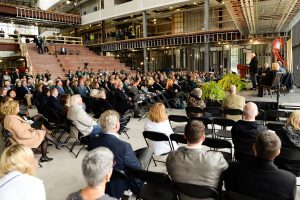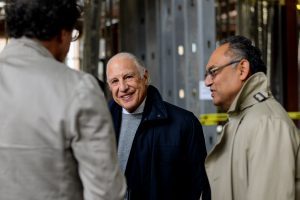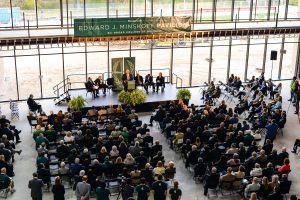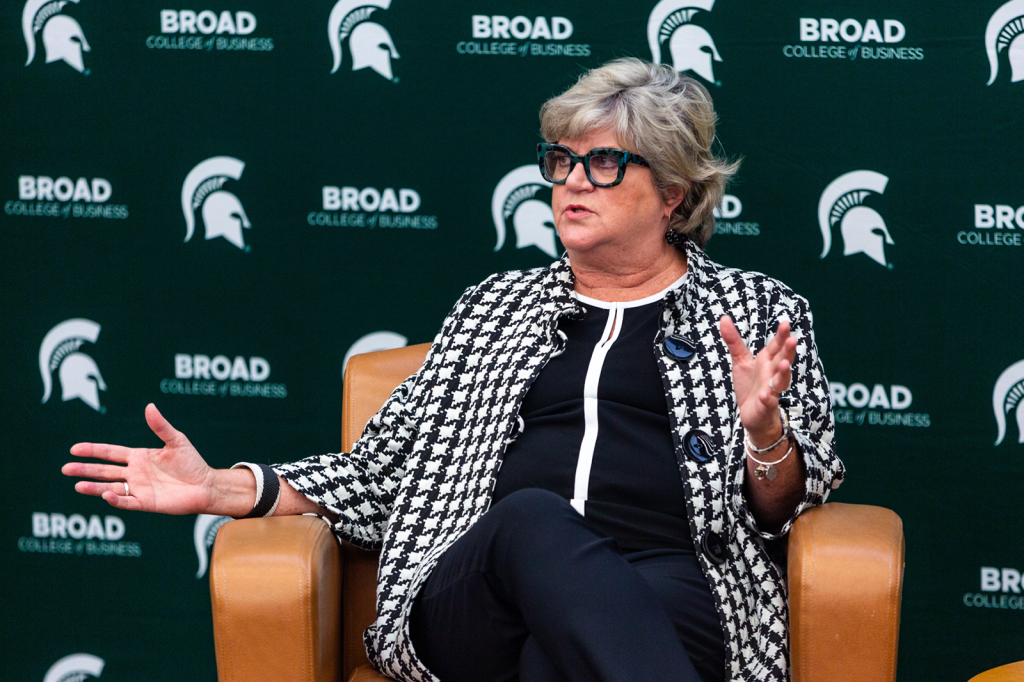Students won’t be able to get inside of the new structure rising adjacent to the Business College Complex until the fall of 2019. But they can immediately start calling it by its new name: the Edward J. Minskoff Pavilion.

Edward J. Minskoff (left center) and Broad College of Business Dean Sanjay Gupta (center) pose with students at the Edward J. Minskoff Pavilion naming ceremony Friday, Oct. 19. Photo by Kasra Raffi
The $62 million collaborative learning center received its formal title at a naming ceremony held inside the building’s work site Friday, Oct. 19 honoring Minskoff (BA Economics, ’62), a Manhattan real estate developer, patron of the arts, and philanthropist, who made a $30 million gift toward the newest Eli Broad College of Business facility.
“This building is going to be spectacular … Michigan State University has been very important to me in many ways,” said Minskoff, adding that undergraduate educations “give you values, they give you the ability to potentially have foresight in doing whatever you decide to do with your lives, whether you are a social worker; whether you’re in construction; whether you’re a doctor or surgeon; it makes no difference. The university is beneficial in one way or another.”
Minskoff’s gift was the largest single donation from an individual ever received by MSU in its 163-year history. But it was far from the first gift from Minskoff, who has been donating to the university for more than five decades and whose assistance helped open the Eli and Edythe Broad Art Museum.

Edward J. Minskoff addresses attendees at the Edward J. Minskoff Pavilion naming ceremony Friday, Oct. 19. Photo by Kasra Raffi
“Many years ago, I said if I was able to achieve success in life through my business, whatever philanthropy I focused on would be in two specific areas: first and foremost is medicine … the second is education,” Minskoff said. “Without it, this country is going to fail.”
Minskoff is founder and president of Edward J. Minskoff Equities, Inc., and in his career he has developed or acquired roughly 40 million square feet of commercial and residential real estate. He has worked with many of the world’s leading architects and architectural firms, including I.M. Pei, Cesar Pelli, and Skidmore, Owings & Merrill.
“He’s focused on developing spaces that are ground-breaking and inspirational, so I think it’s really fitting that his name will forever be on this Pavilion here, because I think this is going to inspire many, many students for many decades to come,” said MSU interim President John Engler.

Edward J. Minskoff (center) and Broad College of Business Dean Sanjay Gupta (right) arrive at the Edward J. Minskoff Pavilion naming ceremony Friday, Oct. 19. Photo by Kasra Raffi
The Minskoff Pavilion was funded entirely through donations from alumni and friends of the college. “There are over 1,500 people that have supported this project … I hope everyone knows how sincerely we thank each and every one of these 1,500 people from the bottom of our hearts,” said Broad College of Business Dean Sanjay Gupta, calling the naming ceremony “a memorable day for Michigan State University, and a very, very special day for the Broad College of Business.”
The roughly 100,000 square foot Minskoff Pavilion will include collaborative spaces for both formal and informal activities; technology to empower students for tomorrow’s business; and flexible areas that can change along with the needs of students and the demands of both educators and employers.

MSU interim President John Engler addresses attendees at the Edward J. Minskoff Pavilion naming ceremony Friday, Oct. 19. Photo by Kasra Raffi
“This is entirely devoted to teaching and learning. There’s not going to be a single faculty office here,” Gupta said. “There are going to be classrooms, team rooms, laboratories, lounges for students, collaborative spaces, a career management center, an events center, even a cafe, with all of that centered around making sure that we can provide the best student experience possible.”
Engler said that “this is truly a building that represents a massive amount of support and confidence in the work of Sanjay and the outstanding business faculty that we have here in the College of Business. It really is an innovative faculty, it’s a hard-working faculty, and it’s a successful faculty. They’re making things happen and this space ought to be a magnet for students who want to come here and learn from these faculty members and learn from each other.”
Reese Morgan, a Broad College junior marketing major and a member of the Broad Student Senate, said “this facility is going to change the entire experience of every single student that walks in the college. It’s going to turn our college into a community … too often I walk these halls (of existing facilities) and see students sitting all over the place, on the floor. They’re working with their groups on the floor. And that is not the experience that we want for these students who have worked so hard to be here.”
“And now they will finally have a place they can go to collaborate; a place they can surround themselves with like-minded students; and a place where they can naturally build relationships with their professors; with alumni; with faculty; and their class,” Morgan said. “And it’s those relationships that are going to build tomorrow’s business.”




